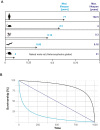Comparative analysis of animal lifespan
- PMID: 37889438
- PMCID: PMC10828364
- DOI: 10.1007/s11357-023-00984-2
Comparative analysis of animal lifespan
Abstract
Comparative studies of aging are a promising approach to identifying general properties of and processes leading to aging. While to date, many comparative studies of aging in animals have focused on relatively narrow species groups, methodological innovations now allow for studies that include evolutionary distant species. However, comparative studies of aging across a wide range of species that have distinct life histories introduce additional challenges in experimental design. Here, we discuss these challenges, highlight the most pressing problems that need to be solved, and provide suggestions based on current approaches to successfully carry out comparative aging studies across the animal kingdom.
Keywords: Aging; Comparative biology; Lifespan; Models of aging.
© 2023. The Author(s).
Conflict of interest statement
The authors declare no competing interests.
Figures


References
-
- Van Houtven G, Honeycutt AA, Gilman B, McCall NT, Throneburg WW, Sykes KE. Costs of illness among older adults: an analysis of six major health conditions with significant environmental risk factors [Internet]. Research Triangle Park (NC): RTI Press; 2008 - PubMed
Publication types
MeSH terms
Grants and funding
LinkOut - more resources
Full Text Sources
Medical

